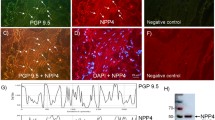Abstract
We have examined the mechanisms of action of a broad spectrum of nitric oxide (NO) donors, including several S-nitrosothiols, sodium nitroprusside (SNP) and nitroglycerine (GTN), in relation to their relaxant activity of urethral smooth muscle. For all the compounds examined, NO release (in solution and in the presence of urethral tissue), relaxation responses, elevations in cGMP levels and the effect of thiol modulators were evaluated and compared with the effect of NO itself.
Whilst all NO donors, except GTN, released NO in solution due to photolysis or chemical catalysis, this release was not correlated with their relaxant activity in sheep urethral preparations, which were furthermore not affected by the NO scavenger 2-(4-carboxyphenyl)-4,4,5,5-tetramethylimidazoline-1-oxyl 3-oxide (cPTIO; 0.3 mM). A substantial NO-generating activity was found for S-nitroso-L-cysteine (CysNO) and S-nitroso-N-acetyl-D,L-penicillamine (SNAP) in the presence of urethral cytosolic fractions, suggesting metabolic activation to NO in the cytosol of the target tissue. In contrast, NO generation from S-nitroso-N-acetyl-L-cysteine (N-ac-CysNO), S-nitrosoglutathione (GSNO) and SNP were reduced by the presence of urethral homogenate and/or subcellular fractions, suggesting direct NO transfer to tissue constituents. NO donors and NO gas induced dissimilar degrees of cGMP accumulation in urethral tissue, while they were essentially equipotent as urethral relaxants. Furthermore, 1H-[1,2,4]-oxadiazole-[4,3-a]-quinoxalin-1-one (ODQ; 10 µM) inhibited both relaxation and cGMP accumulations, but with different potency for the different compounds. Oxidation of sarcolemmal thiol groups with 5-5´-dithio-bis[2-nitrobenzoic acid] (DTNB; 0.5 mM) enhanced relaxations to GSNO, an effect that was reversed by dithiotreitol (DTT; 1 mM), suggesting a direct effect through nitrosylation/oxidation reactions at the cell membrane, while relaxations to NO and to all the other compounds were not affected by these treatments. Finally, photodegradation of SNP induced the formation of a stable intermediate that still evoked NO-cGMP-mediated relaxations. This indicates that the assumption that SNP is fully depleted of NO by exposure to light should be revised.
It can be concluded that important differences exist in the mechanisms by which distinct NO donors relax urethral smooth muscle and they cannot be regarded simply as NO-releasing prodrugs.
Similar content being viewed by others
Author information
Authors and Affiliations
Additional information
Received: 28 December 1998 / Accepted: 14 April 1999 / Published online: 22 June 1999
Rights and permissions
About this article
Cite this article
García-Pascual, A., Costa, G., Labadía, A. et al. Differential mechanisms of urethral smooth muscle relaxation by several NO donors and nitric oxide. Naunyn-Schmiedeberg's Arch Pharmacol 360, 80–91 (1999). https://doi.org/10.1007/s002109900038
Issue Date:
DOI: https://doi.org/10.1007/s002109900038




